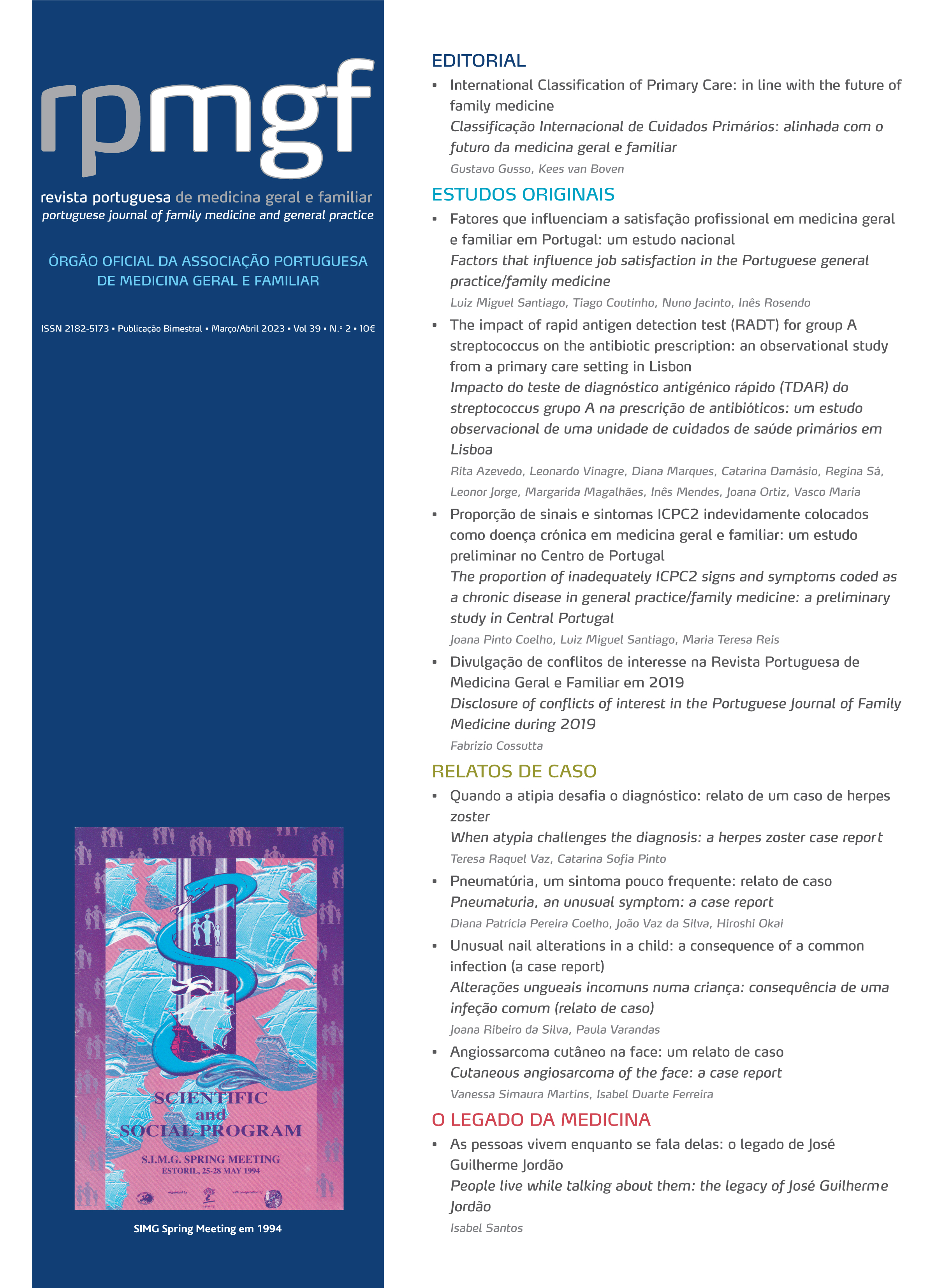Cutaneous angiosarcoma of the face: a case report
DOI:
https://doi.org/10.32385/rpmgf.v39i2.13565Keywords:
Cutaneous angiosarcoma, Clinical case, Early diagnosis, Skin biopsy, ChemotherapyAbstract
Introduction: Angiosarcoma is a rare vascular neoplasm, but with high aggressiveness with high rates of local recurrence and early metastasis. Clinically, it can be confused with simple hematomas or other infectious and inflammatory diseases, often making early diagnosis difficult. Skin biopsy plays a key role.
Case description: We describe the case of a 70-year-old man, leukodermic, with the appearance of a spot in the left eye after two months of evolution, initially in the pre-auricular region with progression to the periocular area; no trauma associated. The patient was referred to a dermatology consultation, having performed a skin biopsy, revealing that it was an advanced epithelioid angiosarcoma of the face. He was followed up in oncology, having undergone a cycle of chemotherapy treatments with pegylated liposomal doxorubicin, showing a favorable evolution of the lesion with no evidence of metastasis until now.
Comment: Early recognition of this type of neoplasm is essential, and the clinician should be diligent in relation to some aspects such as the appearance of skin spots on the face as well as ulcers or skin wounds that do not heal after four to six weeks, allowing a positive impact on the prognosis.
Downloads
References
Morrison WH, Byers RM, Garden AS, Evans HL, Ang KK, Peters LJ. Cutaneous angiosarcoma of the head and neck: a therapeutic dilemma. Cancer. 1995;76(2):319-27.
Mullins B, Hackman T. Angiosarcoma of the head and neck. Int Arch Otorhinolaryngol. 2015;19(3):191-5.
Gründahl JE, Hallermann C, Schulze HJ, Klein M, Wermker K. Cutaneous angiosarcoma of head and neck: a new predictive score for locoregional metastasis. Transl Oncol. 2015;8(3):169-75.
Nakano K, Takahashi S. Precision medicine in soft tissue sarcoma treatment. Cancers. 2020,12(1):221.
Cao J, Wang J, He C, Fang M. Angiosarcoma: a review of diagnosis and current treatment. Am J Cancer Res. 2019;9(11):2303-13.
Kim JD, Santos AB, Kulcsar MA, Cernea CR, Brandão LG. Tumores cutâneos raros em cabeça e pescoço: experiência de 4 anos em uma instituição terciária [Head and neck rare skin tumors: 4 years of experience in a tertiary institution]. Rev Bras Cir Cabeça Pescoço. 2014;43(2):63-71. Portuguese
Fayette J, Martin E, Piperno-Neumann S, Le Cesne A, Robert C, Bonvalot S, et al. Angiosarcomas, a heterogeneous group of sarcomas with specific behavior depending on primary site: a retrospective study of 161 cases. Ann Oncol. 2007;18(12):2030-6.
Yeang MS, Tay K, Ong WS, Thiagarajan A, Tan DS, Ha TC, et al. Outcomes and prognostic factors of post-irradiation and de novo sarcomas of the head and neck: a histologically matched case-control study. Ann Surg Oncol. 2013;20(9):3066-75.
Pezzuto A, Citarella F, Croghan I, Tonini G. The effects of cigarette smoking extracts on cell cycle and tumor spread: novel evidence. Future Sci OA. 2019;5(5):FSO394.
Morgan MB, Swann M, Somach S, Eng W, Smoller B. Cutaneous angiosarcoma: a case series with prognostic correlation. J Am Acad Dermatol. 2004;50(6):867-74.
Stewart FW, Treves N. Lymphangiosarcoma in postmastectomy lymphedema: a report of six cases in elephantiasis chirurgica. Cancer. 1948;1(1):64-81.
Rao J, Dekoven JG, Beatty JD, Jones G. Cutaneous angiosarcoma as a delayed complication of radiation therapy for carcinoma of the breast. J Am Acad Dermatol. 2003;49(3):532-8.
Von Mehren M, Randall RL, Benjamin RS, Boles S, Bui MM, Ganjoo KN, et al. Soft tissue sarcoma, version 2.2018: NCCN clinical practice guidelines in oncology. J Nat Comprehensive Cancer Netw. 2018;16(5):536-63.
Young RJ, Brown NJ, Reed MW, Hughes D, Woll PJ. Angiosarcoma. Lancet Oncol. 2010;11(10):983-91.
Downloads
Published
Issue
Section
License
Copyright (c) 2023 Portuguese Journal of Family Medicine and General Practice

This work is licensed under a Creative Commons Attribution-NonCommercial-NoDerivatives 4.0 International License.
The authors will assign to the RPMGF the sole right to publish and distribute the content of the manuscript specified in this declaration via physical, electronic, broadcasting or any other medium that may come into existence. They also grant the RPMGF the right to use and exploit this manuscript, in particular by assigning, selling or licensing its content. This permission is permanent and takes effect from the moment the manuscript is submitted, has the maximum duration allowed by applicable Portuguese or international law and is of worldwide scope. The authors further declare that this assignment is made free of charge. If the RPMGF informs the authors that it is not going to publish their manuscript, the exclusive assignment of rights ceases forthwith.
The authors authorise the RPMGF (or any entity it may appoint) to act on their behalf when it believes that copyright may have been infringed.





